#mid century britain
Text

Soup Bowl - 1970s
#1970s vintage#vintage crockery#vintage pottery#1970s collectibles#mid century britain#mid century#mid century life
20 notes
·
View notes
Photo

Mary Harpur, Lady Holte by Isaac Whood, c. 1730-52
163 notes
·
View notes
Text

SS Great Britain- she was the largest passenger ship in the world from 1845 to 1854
99 notes
·
View notes
Text
brother william is talking about heretical movements again. his explanation, apparently in service of the idea that heretics don't do it because they're bad christians or bad people, is that these are mostly populist movements in which people denied power are encouraged to seize it. for the leaders of the movements, even if they believe they are seizing power for themselves. "The faith a movement proclaims doesn’t count: what counts is the hope it offers."
this is a cool perspective on heresies! they might be conceived by people who hang out and argue about theology all day, but they aren't living movements until they gain popular support. it's also making me feel "oh, duh!" marginalized people (here "lepers") have literally always been pissed off about being oppressed, but the language they used to talk about it a thousand years ago was religious language, not like the secular way we see popular movements talked about from around the 1600s on. like, the luddites or whatever. they may have given religious justifications for their position, but they're remembered for the position, not the justification! as brother william points out, a heresy is any idea that's inconvenient for the church, and because the church is doing the legislating its objections must be couched in religious terms.
"What must be done?" brother william asks. "Give learning to the simple? Too easy, or too difficult." if they had a sense of perspective they wouldn't be so easy to control! so, same as it ever was, really.
#notr#desperate to know how much of brother william's theory is like.#the way people actually talked and thought about this stuff in the mid 1300s vs 1970s italian political theory yk#presumably I could find this out very easily by just reading some roger bacon + william of occam#it IS fun that eco has made an OC who's friends with all the out-there theologians of 14th century britain
5 notes
·
View notes
Photo

John Everett Millais [English. 1829 - 1896]
Miss Anne Ryan. 19th century
#john everett millais#english#british#england#britain#miss anne ryan#mid 1800s#brunette#oil painting#europe#europa#european#european art#fine art#fine arts#19th century#caucasian#portrait#britannia#northern isles#italy#greece#spain#portugal#france#germany#rome#art
38 notes
·
View notes
Text
The Healthcare Debate Of 1956 - Past Daily After Hours Reference Room
A few good subscribers: Become a Patron!
https://pastdaily.com/wp-content/uploads/2012/08/healthcare-debate-1956.mp3
At the risk of sounding like a broken record and belaboring a point over and over, the argument over Universal Healthcare, Affordable Healthcare, proposed legislation for some subsidized Healthcare are all old issues. Issues that have been at forefront of the American…

View On WordPress
#1950&039;s#1956#Affordable Health Care#Affordable Healthcare#AMA#American Medical Association#Big Pharma#Blue Cross#Britain#Broadcast Journalism#Broadcasts#Conflicts#Congress#Corporate America#Corruption#Democracy#Disconnect#Discussion#Doctors#Health Care#Healthcare#Hospital#hosptialization#medical care#medical treatment#Medicare#Medicine#mid-century america#Middle Class#Radio
0 notes
Text
This is a tag post--eras for my rep muses.
#.// eras: each age a lens (roman britain)#.// eras: each age a lens (500s-1000s)#.// eras: each age a lens (1000s-1500s)#.// eras: each age a lens (1500s-1700s)#.// eras: each age a lens (18th century)#.// eras: each age a lens (early 19th century)#.// eras: each age a lens (mid-late 19th century)#.// eras: each age a lens (early-mid 20th century)#.// eras: each age a lens (mid-late 20th century)
0 notes
Text
History has the power to inform and present broader perspectives on the human experience. For many queer people in the mid 20th century, the history of Classical Greece provided a space where their existence was not just precedented but celebrated. Mary Eileen Challans, known by the pseudonym Mary Renault, was profoundly impacted by ancient Greek literature, which explored same-sex relationships in a way that was unthinkable in contemporary Britain. At times torn between her calling as a writer and her duty as a nurse, Mary authored contemporary and historical novels for over 40 years. They were unusual at the time for their open and empathetic portrayal of queer lives. Her books explored contemporary issues, including both World Wars, the escalating persecution of homosexuals, and apartheid. Throughout all this she was anchored by her partner of 48 years, Julie Mullard.
378 notes
·
View notes
Text
There are several historical contexts for what is going on now in Israel-Palestine that cannot be ignored. The wider historical context goes back to the mid-19th century, when evangelical Christianity in the West turned the idea of the “return of the Jews” into a religious millennial imperative and advocated the establishment of a Jewish state in Palestine as part of the steps that would lead to the resurrection of the dead, the return of the Messiah, and the end of time.
Theology became policy toward the end of the 19th century and in the years leading up to World War I for two reasons.
First, it worked in the interest of those in Britian wishing to dismantle the Ottoman Empire and incorporate parts of it into the British Empire. Second, it resonated with those within the British aristocracy, both Jews and Christians, who became enchanted with the idea of Zionism as a panacea for the problem of anti-Semitism in Central and Eastern Europe, which had produced an unwelcome wave of Jewish immigration to Britain.
When these two interests fused, they propelled the British government to issue the famous – or infamous – Balfour Declaration in 1917.
Jewish thinkers and activists who redefined Judaism as nationalism hoped this definition would protect Jewish communities from existential danger in Europe by homing in on Palestine as the desired space for “rebirth of the Jewish nation”.
In the process, the cultural and intellectual Zionist project transformed into a settler colonial one – which aimed at Judaising historical Palestine, disregarding the fact that it was inhabited by an Indigenous population.
In turn, the Palestinian society, quite pastoral at that time and in its early stage of modernisation and construction of a national identity, produced its own anti-colonial movement. Its first significant action against the Zionist colonisation project came with al-Buraq Uprising of 1929, and it has not ceased since then.
157 notes
·
View notes
Text
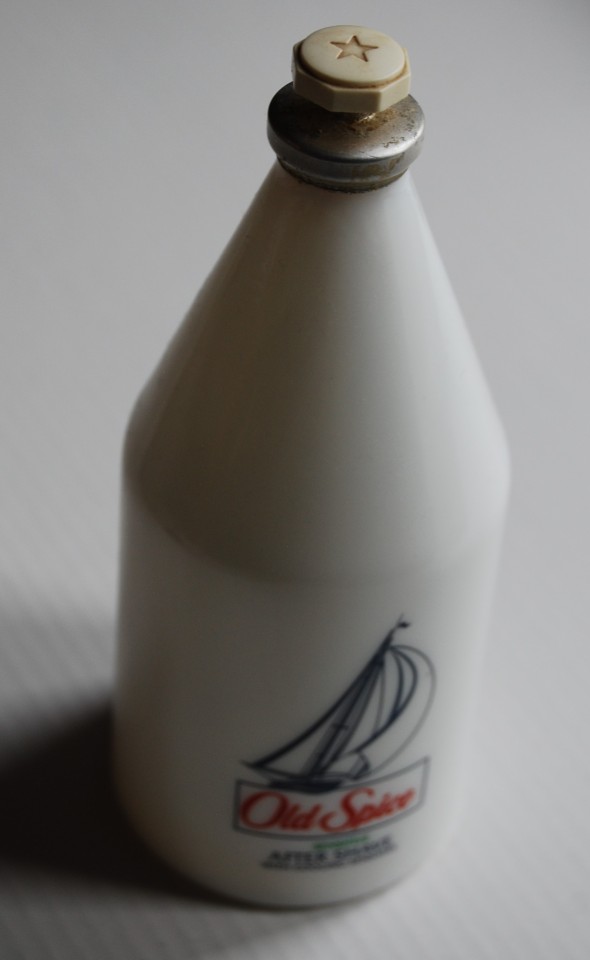
1950s Old Spice Bottle
#vintage old spice#vintage bottles#vintage 1950s#1950s products#old spice#mid century britain#mid century#1950s britain#1950s collectibles
4 notes
·
View notes
Text

Portrait of Mary Aldworth Lailey by Archibald George Barnes
#Archibald George Barnes#Britain#20th c. Britain#mid 20th century#early 20th century#mdp20th c.#20th century
59 notes
·
View notes
Photo

A Nautilus with scrimshawed representations. Depicted are the Great Western and Great Britain steamers of the British Great Western Steamship Company and a coat of arms of the Prince of Wales. Mid 19th century. Now in the Maritime Museum of Greece.
#naval artifacts#scrimshaw#nautilus shell#great western#great britain steamship#mid 19th century#age of sail
168 notes
·
View notes
Text
Gryffindor's Sword
This isn't really a theory for the books, but this really bothered me, so it's more like a little rant, I guess.
See, I love historical weapons (and historical fashion, but that's not what we're talking about now), and I hate the design of Godric Gryffindor's sword in the movies. And I want to rant a little about what Gryffindor's sword would actually look like if anyone bothered to do a quick Google search.
This ornate little thing:

Is not a sword, it's a toothpick. No way would a self-respecting English wizard-warrior of the 11th century use something that looks anything like that. Not only does the blade look pathetic, this sword isn't remotely functional. Here is a summary of some of my complaints about the design (without talking about historical accuracy):
This thing is tiny. Swords shouldn't be this dainty, they need to have some weight behind them so blows would actually do damage. This so-called "sword" is barely better than fighting with a knitting needle.
The hilt is too ornate, it looks purely ceremonial and not functional. Battle-made swords would usually be simpler. All the ornate details on the hilt make it so it'll be incredibly uncomfortable to hold in your hand, which is the last thing you want in a fight.
Additionally, the all-metal hilt would have a very weak grip with little to no friction. It means that in the middle of a duel, you could find the sword slipping out of your hand if your opponent strikes it hard enough.
The blade profile is atrocious. The edge should thin out gradually to improve the cutting, here we see the edge just, thins out really quickly at the end, without gradual tempering. Even kitchen knives have this gradual thinning. But not this sword, I guess no one needed to cut with it.
And it won't be good for stabbing either, as the point is barely pointy (even in other photos). And even if we assume it's pointy, a blade designed for trusting would be thinner at the point than this one (on all planes). That said, thrusting swords in this period would still be better at cutting than the above atrocity.
This sword lacks a fuller (the sort of cave-in in the middle of the blade). The fuller helps reduce weight and strengthen the rigidity of a sword. Magic can help with both these issues, but, the lack of fuller is a mark of a poorly designed sword.
Well-made swords would usually have what's called a "distal taper", which is that the blade gradually thins on the horizontal plane to reduce weight at the point. This is good for balance and stabbing. This is an example of a distal taper on a knife:
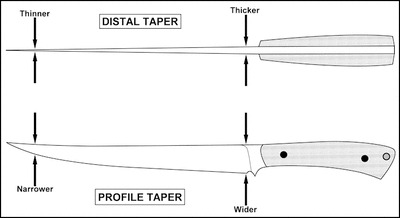
The design from the movies does not have a distal taper and I can guarantee no goblin would look at the abomination the movies called a sword and think it's remotely passable.
So, if we want to talk about what Godric Gryffindor's sword would actually look like?
It'll be something like this:

(11th-century Viking Sword, got popularised in Britain by the Viking invasions)
Or this:

(11th-century Anglo-Saxon Broadsword, existed in Britain since the 5th century in slightly different designs. Yes it is very similar to a Viking sword, it was a common design at the time)
Or even an arming sword that rose in popularity around the mid-11th-century:
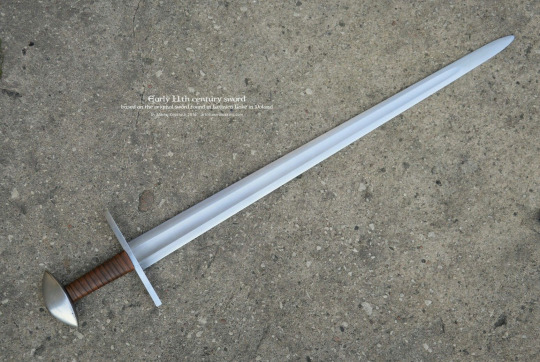
(Early 11th century English Arming Sword)
As an 11th-century English wizard, Godric could've had either of the three.
As for the design described in the book and how it could work with this kind of blade:
A gleaming silver sword had appeared inside the hat, its hilt glittering with rubies the size of eggs.
(CoS, 295)
For the metal, there are two possibilities here:
Harry doesn't know much about swords or metals, I think he could mistake polished steel for silver. Silver is way weaker than steel and depending on forging, another steel sword could cut through it. Pure silver would also not hold its form as much as steel, so a sword design like that of older bronze swords (another softer metal) could be better for it than what was typical for steel swords in the 11th century. Even if the silver is hardened to keep it in shape (which can be done) it would become brittle and break easily. Basically, regular silver is a really bad metal for these kinds of swords, especially if your opponents wield steel. Which brings me to the second option...
The other possibility is that Goblin-forged silver is just magically very strong so it won't break under pressure (like regular hardened silver). Steel swords solve the issue by having some yield to bend instead of snapping, if goblin silver is just magically strong enough that the sword won't snap or the sword is enchanted unbreakable, this would work too.
As for the egg-sized rubies, well, maybe the size of fish eggs? I honestly don't know what JKR was on about here... The sword could have one egg-sized ruby on the pommel (the metal piece at the end of the hilt), but that's it.
If I were to get more specific with the design, I did like that the movies wrote Godric's name on the sword, which is very much possible with a more historically accurate functional sword. Like these Viking/Anglo-Saxon swords from the early 10th century with gold and silver inlay on the blade and hilt (The sword is damaged but it's real):
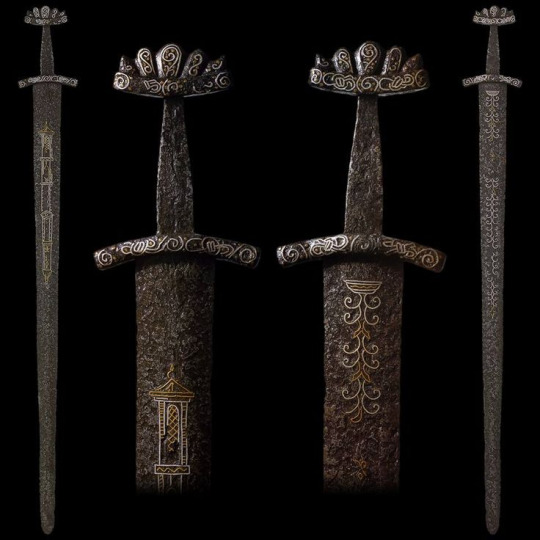
So his name and maybe some other patterns could be written on the sword in silver and gold, which would look really cool, in my opinion.
Also, you could get even decorative on the pommel and crossguard while keeping it functional, including the addition of more precious metals like silver beyond just inlaying it.
Like this replica of 10th-century bronze Viking sword hilt:

Ceremonial swords (not meant for battle) could get even more ornate on the hilt. Like the Essen Sword gifted in 993 A.D that actually has precious stones decorating its pommel and crossguard:
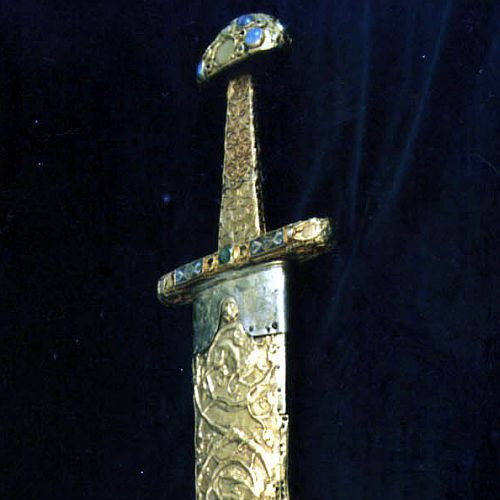
My vision for Gryffindor's sword
Steel blade or magical goblin-forged silver (doesn't really matter) that is shaped like the blades above. Personally, I'm leaning towards an arming sword design, with blade inlays of silver and gold that write the name Gryffindor along with some other magical imagery of lions or dragons.
The hilt would be made of silver (or covered in silver) and have one large ruby on the pommel and/or multiple rubies like in the sword pictured above along with gold inlays. I also imagine the crossguard ending with little lion heads, kinda like the little dragons on this crossguard (The date on this sword is debated to be anywhere between the 8th century to the 13th century, but they could create hilts like this in the 11th century):
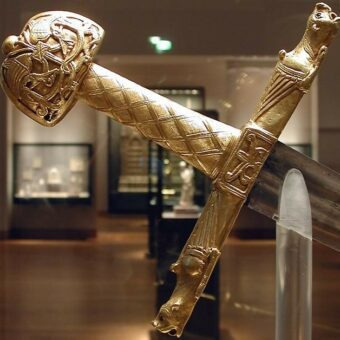
The hilt would have a wrap of leather so there would be a better grip for fighting. No way is Gryffindor carrying a ceremonial sword that he can't use. I think said leather should be painted red.
#harry potter#hp#harry potter thoughts#hp thoughts#rant#i guess#hollowedheadcanon#godric gryffindor#gryffindor's sword#hp films#hp headcanon
67 notes
·
View notes
Note
Hi! So this is gonna sound weird, but I’ve kinda been learning about Irish history backwards? Like, I started with the Troubles (bc of family involvement), then back to the 1916 rising which got me more interested in the people involved which took me further back and etc etc. I know I’ve been doing it “wrong” but I’m just starting to come up to the 1798. Do you happen to have any recommended readings or particular persons of interest to read? Any collections of primary sources would be more than welcome!
Secondary sources I would recommend:
The Year of Liberty by Thomas Pakenham - about the rebellion in general
The People's Rising by Daniel Gahan - about the rebellion in Wexford
The Summer Soldiers by ATQ Stewart - about the rebellion in Ulster
Wolfe Tone: Prophet of Irish Independence by Marianne Elliott - about Wolfe Tone
The Life and Times of Mary Ann McCracken by Mary McNeill - technically this is just about Mary Ann but I think it's pretty good for Henry Joy McCracken too because there aren't many biographies of him
Orangeism in Ireland and Britain 1795 - 1836 by Hereward Senior - obviously exercise caution on whether or not you think you can mentally handle this subject but book about loyalism during 1798
Castlereagh: War, Enlightenment, and Tyranny by John Bew - about Lord Castlereagh
2 things that I would also recommend reading about for context are the French Revolution and the British radical movement of the late 18th century. for the French Revolution 1 book I would say is good is Liberty or Death by Peter McPhee and for the British radical movement... the book The English Jacobins by Carl B Cone does a good enough job
Primary sources:
The Memoirs of Theobald Wolfe Tone by Theobald Wolfe Tone - title is pretty self explanatory. It's Tone's account of his own life + his diary
The United Irishmen, Their Lives and Times by RR Madden - this is considered to be the 1st history of the rising & was written with the help of many people who lived through it, so it includes a lot of first hand accounts. HOWEVER. beware that Madden was your archetypical mid 19th century Catholic Irish nationalist and the bias created due to that shows through in every single part of these books
Memoirs of the different Rebellions in Ireland by Sir Richard Musgrave - this is another very early history of the rising, also written with the help of people who lived through, also including a lot of first hand accounts. HOWEVER. Musgrave is like Madden's Orange counterpart in that this book is also wildly biased and should also be read with a degree of caution
Personal Narrative of the "Irish Rebellion" of 1798, Sequel to Personal Narrative of the "Irish Rebellion" of 1798, and History and Consequences of the Battle of the Diamond by Charles Hamilton Teeling - 3 accounts of politics in Ireland in the 1790s written by someone who as a young man led the Catholic paramilitary the Defenders
The Drennan letters (a collection of letters that Belfast doctor William Drennan and his sister, Martha McTier, wrote to each other between the 1770s and 1820s), if you can find them, are another great primary source on both the United Irishmen & on what life was like back then in general, as are the McCracken letters, which I know are available free online somewhere I just can't remember where exactly I got the pdf from
There are a lot of them but if you're interested in primary sources you might also read some of the political pamphlets/books that were going around back then -- the most famous that come to mind in this context are Wolfe Tone's Argument on Behalf of the Catholics in Ireland, Thomas Paine's The Rights of Man, and Edmund Burke's Reflections on the Revolution in France but there are wayyy more than that and at least some of them are on the internet archive
194 notes
·
View notes
Note
more doctor/curator pleeeaaaase? xo @hardly-an-escape
Far be it from me to deny anyone of more of these two sweet little whores... (I really really like them and will be back to their unhinged shenanigans after the Bang). More under the cut in the middle because NSFW.
Hob is shocked they make it past the entryway after the door to his flat closes behind them.
But, let's be clear, the only reason they do is because Dream sees the tapestry that hangs in the library that opens to the left of the foyer.
The room has no windows, bookshelves from floor to high ceilings on all vertical surfaces except for the rectangle of glass that encases the textile art in a climate-controlled space.
“My God, Hob,” Dream is walking towards it like he is being pulled in by a tractor beam on some spaceship, floating and not of his own volition. “Is this real?”
He comes up behind Dream and wraps his arms around the curator. “Aye,” he rests his chin on a black-clad shoulder, “family heirloom, late 14th century. The story is that one of my ancestors learned tapestry weaving in Paris and brought it back to Kent, taught her children, and their children. Gadling-made work supposedly hung in most castles in southern Britain by the mid-15th century. But this one was kept by the family. Why this particular tapestry over others is lost to time.”
A giant white horse rears up across the silken surface, narrowly avoiding the wolves that attack and weave around its legs. In the forest other beasts watch: owls, foxes, deer, squirrels, songbirds. It is very clearly not a unicorn, which is fascinating because it loses the religious symbolism typical of the period. The sun is setting in the background, making the leaves glow with a burnished copper color.
“It is exquisite,” Dream whispers, leaning back into Hob. “And explains your preference for the Middle Ages.”
“Got it in one,” Hob chuckles. He pushes his hands up the front of Dream's shirt, presses his palms to the flat of his abdomen and digs his fingertips into the trail of dark hair that runs down the center.
Dream sways into it, going pliant in Hob's embrace. “So what's your desired order of operations, doctor? Far be it from me to choose a schedule that might endanger the lives of others by leaving you short on sleep.” He grabs one of Hob's hands and slides it down into his pants, where his cock is sticky and half-hard already. “Also, I think I have a Christmas present I might request of you.” He presses his arse into Hob's groin with a rolling motion, arching his back and moaning obscenely loud when Hob's fingers find the frenum piercing.
Fucking hell this man is such a perfect whore.
“Oh?” Hob murmurs, far more focused on cataloging every little sound and twitch that different tugs and twists of the piercing bring about. Dream is rock hard again within seconds, practically writhing against him, yet he is also the one stringing sentences together.
“Oh yes,” he rocks forward into Hob's hand then back into his crotch. “I want to ride your face until I come with your tongue buried in my arse, then turn around and ride your cock until I come again.”
Hob shivers and groans and uses his free hand to open Dream's fly so he has the space to fondle his bollocks. “You want that before or after I put on my leathers and ride you?”
Dream cries out again, a generous spurt of precum ending up on Hob's hand when he tugs and twists the piercing; apparently a touch of pain isn't bad for this little dove. “Oh, after. Then I'll be on your face longer, waiting for my dick to get back into the game.”
“Mmm, then you'll be riding me even longer after that, just like you want, you insatiable slut.” Hob sucks on the side of his neck, digs his teeth in to bring a bruise to bloom. Dream moans and bucks with the hardest presses of teeth. “Like some pain with your pleasure, dove?”
“Only in small doses.” His long arms swing up and behind Hob's head, tugging his mouth back to his neck. “You?”
Hob gets distracted by expanding the hickey so it flows down to the top of Dream's shoulder. “Not my jam, but I am more than happy to do just about anything that turns my partner on.”
Dream laughs, breathless and happy-sounding, “No wonder you get typecast as a service top.”
Frustrated with the obstacle, Hob pulls Dream's shirt off, flings it somewhere to the side, then continues to paint the skin of his shoulder red and purple with his teeth. “And does everyone assume you're the twinky bottom?” He strokes Dream's cock slowly and grinds his own arousal into that pert little arse.
A gasp interrupts Dream's continued laughing as he grinds back, so much harder than before. “I love surprising people. Upending their expectations. Watching them lose their minds as I expertly take them apart, piece by piece.”
“Expertly?” He can't help but ask.
“What do they say, ten thousand hours to master a skill?” Dream sounds like such a smug little shit and Hob is beyond feral about it.
He moves one hand up to play with the hair on Dream’s chest, to tweak a nipple and hear that lovely little gasp again. “And how much practice have you had, sweet thing?”
“You sure you want the honest answer to that?” He can hear Dream's raised eyebrow.
“Go ahead. Shock me.”
“I stopped counting at one hundred seventy nine different partners.”
Hob freezes, a whine oozing out through his teeth. Bloody fuck.
“Hob?”
“Yeah, give me a sec. If I don't dissociate for a minute I am gonna come in my pants because Christ that is hot. Also explains a lot. My God, how many of those were multiples at once?”
Dream's laugh this time is a deep, sensuous rumble. “Not as many as you might think. And I’ve only been gang banged once.” He turns in Hob's arms, dislodging Hob's hand from his prick and leaning in to speak against Hob's lips, “But that was a long time ago. Now I am more interested in exploring how many different sensations I can have with one partner.”
“Oh, so you plan on going full fluid bond with me, do you?”
The blush on Dream’s face is a gorgeous, deep rose red. “I…” he looks down and away for only a moment and then holds his chin up high, proud and perfect, “yes.”
#Dreamling#Doctor/Curator AU#from that prompt about fake relationship video calls#sequel to “Placebo Effect”#Pavonis writes
85 notes
·
View notes
Text
lowkey losing my shit at the comedic potential of mid/late 18th century British-Danish relations, particularly this part
During its heyday, the Danish East Indian Company and the Swedish East India Company imported more tea than the British East India Company — and smuggled 90% of it into Britain, where it sold at a huge profit.
first off, that's hilarious. second, the potential of Alfred and Mathias running into each other because they're both smuggling tea to sell in England is fucking incredible. and if it's before 1772, then both Alfred and Mathias are members of Arthur's own fucking household.

#hetalia hc#hetalia hcs#hetalia headcanons#historical hetalia#hetalia headcanon#hws america#hws denmark#okay they're OCCASIONAL members of Arthur's household#presumably Alfred mostly lives in the colonies and Mathias in Copenhagen#but Britain and Denmark have a royal marriage during this time and that's as good excuse as any#arthur: I don't understand. where is everyone buying such cheap tea from??? the EIC should be making much more profit than this#mathias: wow that's so weird. don't have a clue how that's happening#alfred: I bet it's ned's fault#mathias: yeah that dutch bastard always gets away with everything
69 notes
·
View notes